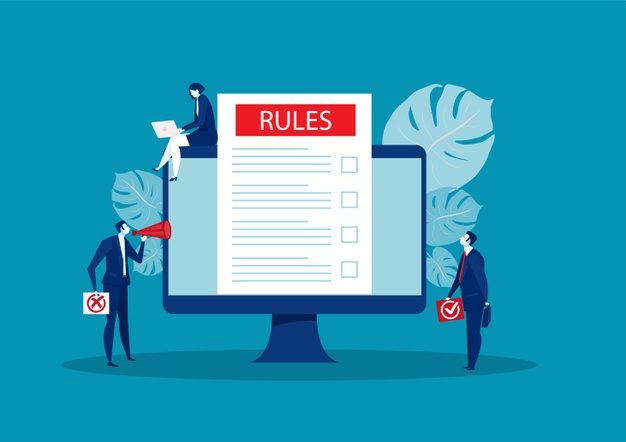Much like the society in which we live, organizations are built upon systems of rules. For many organizations, their rules are largely undocumented. Employees simply perform tasks based on what they know and their experience. Other organizations have highly documented rules systems. Yet this does not mean that employees will always follow the rules or that process inefficiencies will not arise. For that, organizations require business rules engines.
What is a business rules engine?
A business rules engine (BRE) is a software program that executes decision processes based on predefined business logic. It is a core component of a business rules management system (BRMS). A BRMS is a comprehensive software solution that is used to define, deploy, execute, monitor, and manage business rules.
The business rules engine works by communicating with a business rules repository and integrating it into the application core. The business rules engine then executes business rules based on application data and returns the result back to the core.
Benefits of a business rules engine
One of the biggest benefits of a business rules engine is its ability to manage business rules outside of code, allowing it to be maintained by less technical users. This allows users to make updates to business rules without making changes to the application code itself. In addition to being easier to maintain, the solution provides flexibility so organizations can respond to changing needs.
A business rules engine helps organizations to improve compliance. The BRE only executes processes that comply with internal policies and regulations. It also creates audit trails and provides stakeholders with valuable insights into business processes. Business rules engines also automate manual and repetitive tasks, improve collaboration and approval processes, and reduce the occurrence of costly errors.
When to use a business rules engine
In every organization there are hundreds, or even thousands of decisions made on a daily basis. These decisions are often made by human employees that give little thought to the process, simply doing what they always do in a way that they think it is supposed to be done. Yet this results in inconsistencies across the organization and produces outcomes that do not always align with organizational policies and objectives.
Having workflows governed by established business rules results in accurate and efficient decision-making and process execution. Some of the types of decision logic that organizations can implement with a business rules engine include the following.
Multi-step decision workflows
Note that a business rules engine is not the same thing as a workflow engine. A workflow engine automates end-to-end multi-layered processes while a BRE evaluates expressions and decision criteria. It is possible, however, to automate multi-step decision workflows with a business rules engine.
Business rules are a core component of workflow functionality since workflows involve decision-making processes. For example, a loan application workflow could route a request in different directions based on the applicant’s credit score.
Rules that run requirements
Business rules specify what you can or cannot do and provide the criteria for making decisions. Business requirements, however, determine what you need to do to implement and comply with a business rule. Like business rules, organizations can have a potentially unlimited number of business requirements. With a business rules engine, organizations can implement requirements for each rule.
Conditions that produce outputs
Conditions, or the left-side of an “if-then” business rule statement, includes the attributes that must be met to execute an action to produce a given output. For example, an ecommerce website selling alcohol requires customers to be over the age of 21. If the customer is over 21, he or she can buy alcohol. However, if the customer is under 21 then the rule declining the transaction is triggered.
Scoring
Organizations can create rule sets that produce numerical values for the purposes of scoring. Each rule in the set contributes to the total value to give organizations a means of evaluating. Common uses of scoring range from generating credit scores to loan approvals to product pricing.
Calculation scripts
Calculation scripts are text files that define how to calculate data in a database. A calculation script can be associated with a single database or access multiple databases. A calculation script can be used for something like quickly calculating a financing rate based on the loan amount, borrower’s credit scores, and other applicable loan attributes.
Population segments
Organizations can create unique population or customer segments based on specified factors. Behavioral population segmentation is often used in marketing. Marketers can divide consumers based on their level of interaction with the organization and tailor their ads accordingly.
Predictive machine learning models
One potential limitation of business rules management systems is difficulty codifying logic and making decisions. Consider for example a life insurance application that can involve many variables. With so many unique combinations, it can be difficult to break the process down into specified business rules. Thus, human decision-making is often required.
With predictive machine learning models, however, humans are not required to create specific rules. The machine creates models based on raw historical data that generate future predictions to enable highly informed decisions.
API integrations with data sources
An API, or application programming interface, makes it easy for organizations to connect and integrate different applications. Moreover, organizations can use APIs to easily connect to different data sources. These data sources work with the business rules engine to execute applicable business logic and rules.
Choosing a business rules engine
The right business rules engine for your organization is largely dependent on the types of rules that you want to implement, the attributes of end-users, and your unique business needs. Large organizations with complex workflows and automation needs often require custom solutions that are both cost prohibitive for smaller organizations.
For more information, check out ProcessMaker’s latest webinar: How to Integrate Business Rules and Decision Management Into Your Workflows





